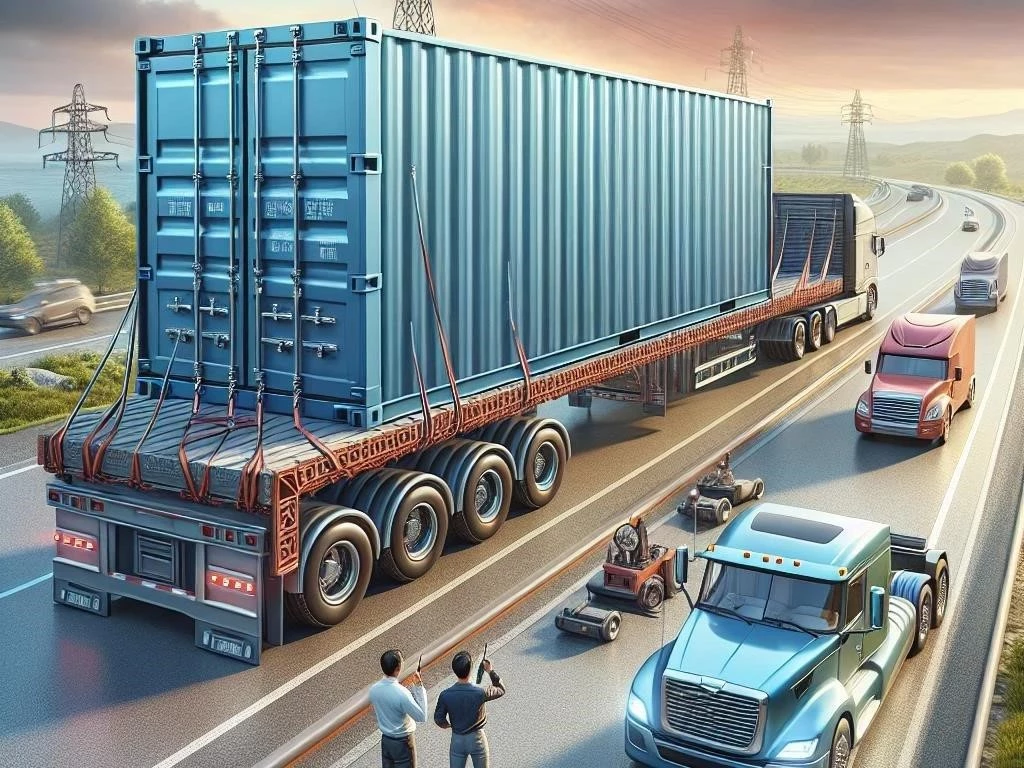How to Transport a Shipping Container
Transporting shipping containers involves careful planning, utilizing appropriate methods, and adhering to regulations ensuring safe and efficient movement of goods across various logistics networks.
1.1 Importance of Efficient Transport Logistics
Efficient transport logistics are crucial for successful shipping container transport, ensuring timely delivery and minimizing costs. Proper logistical planning streamlines operations, optimizing routes and reducing delays. Effective cargo handling and adherence to shipping regulations enhance safety and compliance, while choosing the right shipping methods facilitates smooth intermodal transport. Coordinating between various transportation modes, including flatbed trucks and cranes, is essential for managing container dimensions and ensuring secure delivery. Ultimately, efficient logistics improve overall freight services, benefiting both businesses and customers alike.
1.2 Overview of Freight Transportation Methods
Freight transportation methods play a vital role in moving shipping containers efficiently across various distances. These methods include sea, air, and land transport, each with unique advantages. Sea freight is cost-effective for large volumes, while air freight offers speed for urgent deliveries. Land transport, utilizing trucks or rail, provides flexibility for regional distribution. Intermodal transport combines these methods for optimized logistics. Understanding these options helps businesses select suitable delivery options, ensuring timely and safe cargo shipping while meeting specific logistical needs.
Understanding Shipping Containers
Shipping containers are essential for transporting goods, providing secure storage solutions. Understanding their types, dimensions, and specifications is crucial for effective logistical planning and cargo handling.
2.1 Types of Shipping Containers
Shipping containers come in various types, each designed for specific cargo needs. Standard dry containers are versatile for general goods, while refrigerated containers maintain temperature-sensitive items. Open-top containers facilitate loading bulky machinery, and flat-rack containers are ideal for oversized cargo. Tank containers transport liquids safely, while high cube containers offer extra height for larger shipments. Understanding these types ensures appropriate selection for efficient transport logistics, enhancing safety and compliance with shipping regulations while accommodating diverse cargo handling requirements during transportation.
2.2 Container Dimensions and Specifications
Understanding container dimensions and specifications is critical for effective shipping container transport. Standard containers typically measure 20 or 40 feet in length, with heights of 8.5 or 9.5 feet. Widths generally remain consistent at 8 feet. It is essential to know the maximum cargo weight and volume capacity to ensure compliance with shipping regulations. Additionally, precise measurements prevent issues during loading and unloading, facilitating seamless crane operation and efficient cargo handling at loading docks or container yards, enhancing overall logistical planning.
Moving Containers: Initial Considerations
When moving containers, it’s essential to assess specific needs, understand transportation logistics, and choose suitable equipment. Proper planning ensures efficient and safe container transport operations.
3.1 Assessing Your Needs for Shipping
Assessing your shipping needs is crucial for successful container transport. Begin by determining the type and volume of cargo, considering factors like weight, dimensions, and fragility. Evaluate the distance and destination to select appropriate shipping methods and delivery options. Additionally, identify any special requirements, such as temperature control or hazardous material handling. Understanding these parameters allows for effective logistical planning and ensures compliance with shipping regulations. Ultimately, a thorough assessment leads to optimized freight transportation and minimized costs during the process.
3.2 Choosing the Right Container for Your Cargo
Choosing the right container for your cargo is essential to ensure safe transportation. Start by identifying the type of cargo, as different containers are designed for specific needs. For example, standard dry containers suit general goods, while refrigerated containers are necessary for perishables. Consider the cargo dimensions to select a container that accommodates the items without exceeding weight limits. Understanding shipping regulations and container specifications also aids in making informed decisions, ultimately enhancing the efficiency of freight transportation and cargo handling.
Preparing for Container Loading
Preparing for container loading involves organizing cargo efficiently, ensuring safety measures are in place, and following best practices to facilitate smooth and secure loading operations.
4.1 Best Practices for Cargo Handling
Implementing best practices for cargo handling is vital for ensuring safe and efficient container transport. Begin by inspecting all cargo for damage before loading. Use appropriate equipment, like forklifts and dollies, to minimize physical strain and reduce the risk of accidents. Properly distribute weight within the container to maintain balance during transport. Additionally, secure cargo with straps or barriers to prevent shifting. Training personnel on loading protocols and safety measures enhances overall efficiency and compliance with shipping regulations throughout the process.
4.2 Safety Measures During Container Loading
Implementing safety measures during container loading is crucial to prevent accidents and ensure efficient operations. Always wear appropriate personal protective equipment, such as helmets and gloves, while handling cargo. Ensure the loading area is clear of obstacles and well-lit to enhance visibility. Utilize properly maintained equipment, such as cranes and forklifts, to minimize risks. Establish clear communication among team members, especially during crane operation. Regularly conduct safety training and drills to reinforce protocols, ensuring compliance with shipping regulations and enhancing overall safety.
Shipping Methods Overview
Understanding various shipping methods is essential for transporting containers efficiently. Each method offers distinct advantages, influencing cost, speed, and suitability for different cargo types.
5.1 Intermodal Transport Options
Intermodal transport options combine different shipping methods to enhance efficiency and flexibility in container transport. This approach utilizes multiple modes, such as trucks, trains, and ships, to optimize logistics. By transferring containers between transport systems without reloading cargo, businesses can reduce transit times and costs. This method is particularly beneficial for long-distance transportation, allowing for seamless coordination across various networks. Understanding intermodal transport options ensures effective logistical planning, enabling timely delivery and improved cargo handling throughout the shipping process.
5.2 Comparing Delivery Options: Sea, Land, and Air
When transporting shipping containers, comparing delivery options—sea, land, and air—is essential for effective logistics. Sea freight is cost-effective for large shipments but slower. It’s ideal for international transport, accommodating diverse cargo types. Land transport, using trucks or trains, offers flexibility for regional deliveries and faster transit times than sea. Air freight is the fastest option, suitable for urgent or high-value goods, but generally more expensive. Assessing these delivery options ensures optimal logistical planning, meeting specific shipping and budgetary requirements.
Crane Operation for Container Handling
Crane operation is vital for efficient container handling, ensuring safe loading and unloading processes. Proper training and adherence to safety protocols enhance operational effectiveness and compliance.
6.1 Types of Cranes Used in Container Transport
Various types of cranes are utilized in container transport, each serving specific functions. Gantry cranes are commonly used at ports for loading and unloading containers from ships, providing excellent height and reach. Mobile cranes offer flexibility, allowing for container handling in various locations. Ship-to-shore cranes efficiently transfer containers directly between vessels and the dock. Additionally, telescopic cranes are useful for reaching containers stacked at heights. Understanding these crane types enhances operational efficiency and safety in container handling processes during transportation.
6.2 Safety Protocols for Crane Operation
Adhering to safety protocols for crane operation is essential to prevent accidents during container handling. Operators must undergo rigorous training and certification to ensure competency. Conducting regular inspections of the crane and its components minimizes malfunction risks. Establishing clear communication signals among team members during operations enhances safety. Implementing load limits and using appropriate rigging techniques are crucial for secure lifting. Additionally, maintaining a safe distance from the crane’s swing radius protects personnel and equipment, ensuring compliance with established safety regulations.
Transportation Vehicles for Shipping Containers
Transportation vehicles play a crucial role in shipping container logistics. Selecting appropriate trucks, trains, or ships ensures efficient movement, timely delivery, and safe cargo handling throughout transport.
7.1 Flatbed Truck Utilization in Freight Services
Flatbed trucks are essential in freight services for transporting shipping containers, especially for oversized or heavy cargo. Their open design allows easy loading and unloading of containers, accommodating various sizes and types. These trucks are particularly beneficial for intermodal transport, seamlessly transferring containers between different transportation modes. Utilizing flatbed trucks enhances logistical flexibility, enabling efficient deliveries to remote or hard-to-reach locations. Additionally, they provide stability during transit, ensuring the safety of the cargo while adhering to shipping regulations and weight limits.
7.2 Role of Heavy Machinery in Container Transport
Heavy machinery plays a vital role in container transport, facilitating efficient loading, unloading, and movement of shipping containers. Equipment such as forklifts and reach stackers are essential for handling containers in ports and container yards, ensuring quick and safe operations. Cranes, especially ship-to-shore cranes, enable the seamless transfer of containers between vessels and docks. Additionally, heavy-duty trucks equipped with hydraulic systems allow for secure transportation of containers over various terrains. Utilizing this machinery enhances overall efficiency and compliance with shipping regulations during transport.
Container Yards and Loading Docks
Container yards and loading docks are critical components in shipping logistics, facilitating efficient handling, storage, and transfer of shipping containers throughout the transportation process.
8.1 Functions of a Container Yard
A container yard serves multiple essential functions in the transport of shipping containers. Primarily, it acts as a storage facility, providing a secure area for containers awaiting transport or pickup. Additionally, container yards facilitate efficient loading and unloading operations, allowing for seamless transitions between various transport modes. They also play a crucial role in inventory management, enabling tracking of container locations and status. Furthermore, container yards support maintenance and inspection activities, ensuring compliance with shipping regulations and enhancing overall operational efficiency.
8.2 Efficient Operations at the Loading Dock
Efficient operations at the loading dock are crucial for successful container transport. This begins with proper scheduling to minimize wait times for trucks and cranes. Implementing standardized procedures for loading and unloading enhances workflow and safety. Personnel should be trained on equipment operation and safety protocols to prevent accidents. Utilizing technology for inventory tracking and communication streamlines processes, ensuring timely updates on container status. Regular maintenance of loading equipment, such as forklifts and cranes, is essential to avoid delays and maintain compliance with shipping regulations.
Logistical Planning for Container Transport
Logistical planning is essential for successful container transport, encompassing route optimization, scheduling, resource allocation, and adherence to regulations, ensuring efficient and timely delivery of cargo.
9.1 Importance of Strategic Logistical Planning
Strategic logistical planning is crucial for optimizing container transport efficiency, reducing costs, and ensuring timely deliveries. By analyzing routes, transportation modes, and potential obstacles, companies can create comprehensive plans that mitigate risks. Effective logistical planning also facilitates coordination among various stakeholders, including carriers, port authorities, and customers, enhancing communication and collaboration. Additionally, it allows for better resource allocation, ensuring that equipment and personnel are utilized effectively. Ultimately, strategic planning leads to improved customer satisfaction and a more competitive position in the shipping industry.
9.2 Coordinating with Freight Services for Timely Delivery
Coordinating with freight services is essential for ensuring timely delivery of shipping containers. Establishing clear communication channels with freight providers enables real-time updates on shipment status and potential delays. Collaborating closely with logistics partners allows for better resource allocation and streamlined operations, minimizing transit times. It’s crucial to align schedules and delivery windows, ensuring that all parties are informed of timelines. Additionally, understanding each freight service’s capabilities and limitations aids in selecting the most efficient transport options for specific cargo requirements.
Understanding Shipping Regulations
Understanding shipping regulations is vital for transporting containers legally and efficiently. Compliance ensures safety, minimizes delays, and avoids penalties, ultimately enhancing overall logistics and operational effectiveness.
10.1 Key Regulations for Freight Transportation
Key regulations for freight transportation govern the safe and efficient movement of shipping containers. These include international standards set by organizations such as the International Maritime Organization (IMO) and the International Air Transport Association (IATA). Compliance with customs regulations is vital to prevent delays and fines during cross-border shipments. Additionally, adhering to weight limits, cargo securing methods, and hazardous material handling regulations ensures safety throughout the transport process. Understanding these regulations is essential for maintaining operational integrity and protecting cargo during transit.
10.2 Compliance and Documentation Requirements
Compliance with documentation requirements is crucial for the successful transport of shipping containers. Essential documents include the bill of lading, which outlines shipping terms, and commercial invoices detailing cargo contents and value. Customs declarations must accurately reflect the cargo to avoid delays or fines. Additionally, securing necessary permits for specific cargo types, such as hazardous materials, is vital for legal transport. Ensuring all documentation is complete and accurate facilitates smooth customs clearance and adherence to international shipping regulations, enhancing overall logistics efficiency.
Storage Solutions for Shipping Containers
Effective storage solutions for shipping containers are essential for managing inventory, ensuring secure storage, and facilitating smooth operations during the transportation process and logistics management.
11.1 Temporary vs. Permanent Storage Options
When considering storage solutions for shipping containers, it’s essential to differentiate between temporary and permanent options. Temporary storage is ideal for short-term needs, such as during transportation delays or transshipment, allowing flexibility and quick access. This option often utilizes container yards or warehouses. Conversely, permanent storage solutions are suitable for long-term needs, such as managing excess inventory or seasonal goods. These facilities typically offer enhanced security and infrastructure support. Evaluating specific needs helps determine the most effective storage solution for containers.
11.2 Security Considerations in Container Storage
Security considerations are paramount when storing shipping containers to protect cargo from theft and damage. Implementing access control measures, such as security personnel and surveillance systems, enhances safety. Utilizing high-security locks and seals on containers prevents unauthorized access. Additionally, selecting storage facilities located in secure areas with proper fencing and lighting is crucial. Regular inspections of storage sites ensure compliance with security protocols. By prioritizing these measures, businesses can safeguard their assets, ensuring safe and efficient transport of containers throughout the logistics process.
Implementing best practices for transporting shipping containers enhances efficiency, safety, and compliance. Strategic planning, effective communication, and adherence to regulations ensure successful and timely container transport.
12.1 Summary of Key Points
Transporting shipping containers effectively requires careful logistical planning, adherence to shipping regulations, and understanding of various transportation methods. Key aspects include selecting appropriate vehicles, ensuring safety during loading and unloading, and coordinating with freight services for timely delivery. Additionally, understanding storage solutions and security considerations protects cargo. Compliance with documentation requirements is essential to avoid delays. By implementing these best practices, businesses can enhance operational efficiency, minimize risks, and ensure the successful transport of containers across diverse logistics networks.
12.2 Final Thoughts on Efficient Container Transport
Efficient container transport is vital for maintaining supply chain integrity and customer satisfaction. Companies must prioritize strategic planning, effective communication, and compliance with regulations to streamline operations. Emphasizing safety during handling and transport minimizes risks and potential losses. Leveraging technology for tracking and inventory management enhances visibility throughout the transportation process. Additionally, fostering strong relationships with logistics partners can lead to better service and collaboration. Ultimately, investing time and resources into these practices ensures successful and efficient container transportation in today’s competitive market.














Post Comment